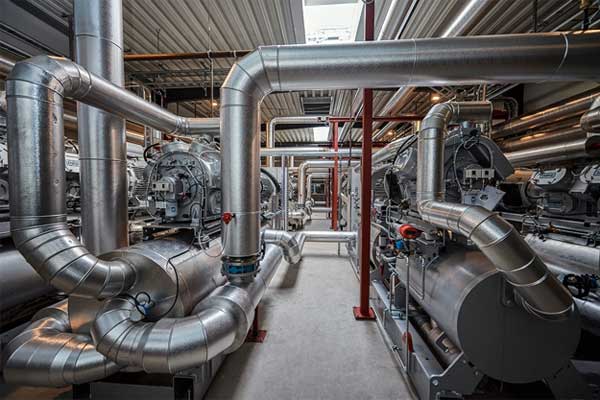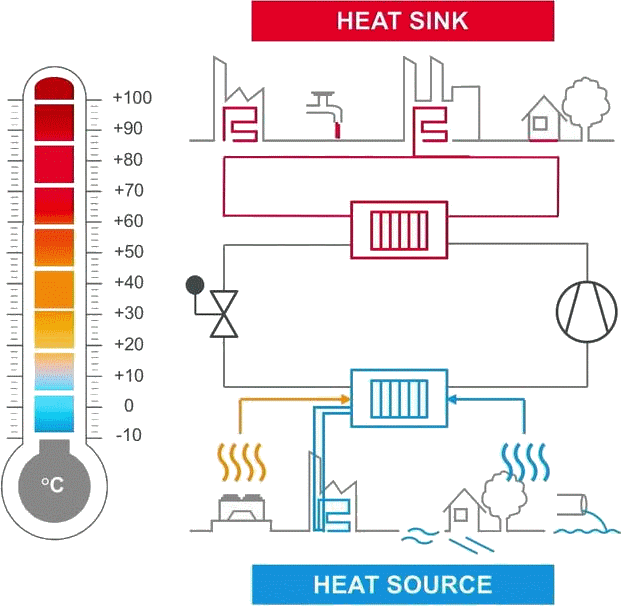What are industrial heat pumps?
Heat pumps are high-efficiency heat source that upgrade ambient or waste heat to useful temperatures by using relatively small amounts of electricity.
Industrial heat pumps are designed to meet industrial process heat loads and operating requirements and are emerging as key tools to decarbonise industrial process heat.
An industrial heat pump is generally larger and has a higher capacity than a residential or commercial heat pump and is generally designed for higher operating load factors, discharge temperatures and reliability. Additional features such as instrumentation, control systems and compliance with hazardous environments may be present.
So how does a heat pump work?
Electric heat pumps use a vapor compression cycle with a refrigerant as the working fluid. The low-pressure refrigerant absorbs heat from a low-temperature source (ambient air or a waste heat stream). It is then compressed, which raises the temperature to the desired level and allows heat to be extracted through a heat exchanger. This process can provide heat more efficiently than conventional liquid heating (e.g., a fossil fuel boiler).
Heat pump characteristics
High temperature heat pumps - Heat pumps capable of reaching temperatures above 60°C are usually designed specifically for specific applications such as heating (e.g., used for cooking, blanching and melting), spot cleaning, drying/evaporation and sterilization/pasteurization.
Currently available heat pumps are generally limited to temperatures below 100°C, making them suitable for producing hot water but not steam. Although not widely available, temperatures up to 150°C can be achieved if waste heat of about 100°C is available as an input. For temperatures between 150°C and 200°C, heat pumps require special refrigerants and compressors, for which technologies are still at an early prototype stage. Research currently underway shows that industrial heat pumps can achieve temperatures in excess of 200°C.
Low temperature heat pumps - Low temperature heat pumps can reach 60-65°C fairly easily with ambient air and are usually generic, off-the-shelf products. To reach higher temperatures, alternative refrigerants, compressors and often multiple stages are used, affecting cost and performance.
Heat source efficiency - Industrial heat pumps often use waste heat or low-grade heat source as heat Reference(s), for example, heat released from processes such as refrigeration. This provides higher efficiency by using higher source temperatures than ambient heat pumps and allows them to be better integrated and smaller in size. Integrating heat pumps with industrial refrigeration systems to use waste condenser heat as a heat source can work particularly well because both systems can benefit. Proper integration is important for the heat pump to perform optimally.
 Image.. www.danfoss.com
Image.. www.danfoss.com
What industries are heat pumps suitable for?
Industrial heat pumps are gaining popularity internationally to meet process heat needs in various industries, including..
- Production of dairy products
- Production of meat products
- Food and beverage production
- Production of wood products
- Production of textiles, leather, clothing and footwear
- Indoor cultivation
- Agriculture
Benefits of heat pumps
Heat pumps have multiple advantages over fossil fuel boilers.
High efficiency and low carbon emissions - Heat pumps have a high coefficient of performance (COP) of 3.0 to 5.02 (fossil-fuel boilers typically have a COP of 0.75 to 0.95).
Convenience and cost - Heat pumps are compact, easy to install and they avoid boiler room costs; heat pumps can often use existing electricity supplies when retrofitted.
No combustion products - Electric-powered high-temperature heat pumps have no emissions (e.g., no combustion products to dispose of such as ash or flue gases including NOx and SOx, and no coal dust) and are cleaner than a boiler-based heating system. Therefore, they usually do not require a permit.
Safe and highly durable - Heat pumps are reliable. They contain proven components and built-in controllers to self-regulate their operation.
Highly responsive - Staged compressors and variable speed drives offer fast load response and good turndown control.
Less maintenance - Components degrade less quickly in heat pumps because of the lower component temperatures, meaning less maintenance is required.
Smaller physical size - No fuel storage is required. This can significantly reduce the physical size of the heating system compared to a fossil fuel alternative. Multiple heat pumps can be spread across a site (if the site is suitable) close to the heating demand, reducing heat losses in the distribution network and making the heating system more efficient.
Future-proofing - Future electricity grids require faster responses to changes in demand; heat pumps can provide cost-effective demand response options.
Does a heat pump have disadvantages?
While there are many advantages to using heat pumps for industrial process heat, there are also potential challenges or circumstances where an alternative solution may be better for your business.
High-temperature process heat applications - Today, industrial heat pumps are mainly used for low-temperature processes below 100 °C. Temperatures above that are better suited for a biomass or electric boiler.
Network costs - Capacity, time-of-use and peak demand costs can mean that heat pumps incur significant costs during certain periods. It may make sense to use heat pumps alongside non-electric boilers, or with heat storage for use during peak periods of electricity demand and to increase system resiliency. With variable speed control, the heat pump's electric demand can also be temporarily reduced during times of high electricity demand on site or in the grid, to respond to electricity rates or participate in demand response programs.
Electricity supply requirements - Industrial heat pumps typically draw about a quarter to a third of the equivalent thermal load as electricity, so they may require an increase in a site's electricity supply capacity. On-site wiring and switchgear can be expensive - especially for longer distances.
Quality heat Reference(s) - Heat pumps need reliable heat source for efficient operation. The closer the heat source is to the outgoing temperature, the higher the efficiency. Air-Reference(s) heat pumps may not perform as well and provide less power in cold weather.
Complexity - High-temperature heat pump systems can be technically complex and expensive to design and install. Maintenance personnel may need to be retrained in the new technology.
Low use factors - A heat pump costs a lot of money, so if your use factors are low, the energy and carbon savings may not be high enough to recover the capital cost.
References..
www.eeca.govt.nz / www.danfoss.com / www.atlascopco.com

